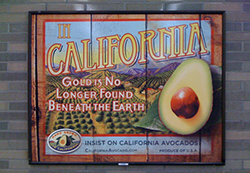I once heard that more avocados are consumed on Super Bowl Sunday than on any other day of the year. This is wrong: Super Bowl Sunday doesn’t touch the 14 million pounds of avocado consumed on Cinco de Mayo. Still, about eight million pounds of avocado have reportedly been mashed into guacamole in honor of the big game in recent years — about 5% of total sales, nothing to scoff at so long after the crop’s seasonal peak.
Most of the avocados we buy to make a summer dip in the dead of winter are Hass avocados, grown in coastal California or, since 2007, in Mexico. (The avocado tree originated in Mexico and Central America, but those zones were closed off to U.S. importers until recently due to an apparently unfounded fear of fruit flies.) Avocados are technically in-season almost year round. The fruits don’t ripen while on the tree, so they don’t have the limited harvest window that other temperate-zone tree fruits have, and avocado fruits can mature all year in the hot, humid climates they prefer. But mature fruits are sparser in midwinter than they are in the summer months; this is usually reflected in the grocery store price. Avocados already come at a high price; though they are a relatively low-maintenance crop, they require particular care to make it to consumers across the states. The fruits must be handpicked when they are green and hard, then kept cold during shipment to prevent ripening and bruising, then (in many locations) kept in a “ripening room” or warm humid place so that customers may purchase them table-ready. From this perspective, avocado is a luxury food: high maintenance and high cost compared to other produce farmed in the States.
This makes guacamole an unusual component of the typical Super Bowl snack spread. Super Bowl Sunday is a celebration of popular culture: the game of the people, watched by millions; easy-to-make, easy-to-eat snacks to be shared in easy camaraderie; attention-grabbing ads celebrating the same menu (the most memorable commercials seem to always promote snack chips or beer). Super Bowl food should be satisfyingly salty or sweet, perhaps extreme, eaten with the hands if possible, and in sufficient quantity to keep a roomful of people content for a four-hour game. Certainly guacamole satisfies most of these requirements: savory, high-fat avocado is a wonderfully satisfying fruit, and when mixed with tangy tomatoes and lime juice, it’s hard to stop scooping it up on tortilla chips until it’s gone. But at $1 a pop, even on sale, avocadoes might cause an economically savvy host to think twice about making enough for a long party.
So what brought this creamy green treat, considered a “cocktail savoury” in Constance Spry’s mid-century Cookery Book, to share a table with saltier, crunchier snacks from bags and jars? The watershed seemed to occur in the 1980s — at least, you don’t really see “guacamole” and “Super Bowl” in the same sentence before then. In the 1980s, California saw a boom in avocado farm start-ups — a small-scale “green gold” rush, news outlets joked; easy avocado trees were the perfect crop for the gentleman farmer. More avocado farms meant a greater — and cheaper — avocado supply for the end user. This bounty, combined with the establishment of commissions to promote avocados and protect grower interests, triggered the classic feedback loop that mainstreams “exotic” food into American culture: The more visible and widely distributed a food becomes, the less strange it seems; the less strange it seems, the more widespread it becomes. You can see this cultural shift in a couple of banner years between the middle and end of the last century: A mid-summer bumper crop in 1960, two years before Jackie Kennedy served an avocado and crabmeat salad at a formal state dinner, caused the price per avocado to drop to around 15 cents — roughly equivalent to $1.17 today, which we’d consider a bit high for a record low. In 1987, when Californians had been slicing avocado onto every burger and sandwich for about a decade, a similar surplus crop allowed New Yorkers to buy at 30 to 50 cents apiece (60 cents to $1 today).
So avocados became more familiar and easy to find over time; at the same time, they were still closely linked with California and other tropical zones — and by association, with vacation and leisure and other pleasant ideas. With limes (a similarly tropical fruit) and the pico de gallo or spicy salsa so often mixed in, guacamole became less an appetizer for formal dinners and cocktail parties, and more of a reminder of the ease and satisfaction of a tropical getaway. Perhaps, then, it’s a natural accompaniment for a smorgasbord usually designed for instant gratification and companionable eating.
Fortunately — and unlike most other foods of the Super Bowl Sunday table — avocados have been given the kiss of beneficence from nutritional experts. It’s not surprising, then, that at the beginning of 2012, avocado sales saw a 30% spike from the previous year. Avocados may be a luxury food in terms of price and environmental footprint, but that’s nothing compared to the luxury of eating a satisfying, energizing snack that also enjoys widespread adulation as a heart-healthy superfood. • 30 January 2013




